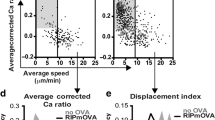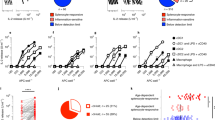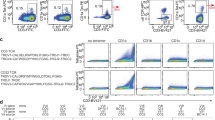Abstract
The interaction between the T cell antigen receptor (TCR) expressed by natural killer T cells (NKT cells) and the antigen-presenting molecule CD1d is distinct from interactions between the TCR and major histocompatibility complex (MHC). Our molecular modeling suggested that a hydrophobic patch created after TCRα–TCRβ pairing has a role in maintaining the conformation of the NKT cell TCR. Disruption of this patch ablated recognition of CD1d by the NKT cell TCR but not interactions of the TCR with MHC. Partial disruption of the patch, while permissive to the recognition of CD1d, significantly altered NKT cell development, which resulted in the selective accumulation of adipose-tissue-resident NKT cells. These results indicate that a key component of the TCR is essential for the development of a distinct population of NKT cells.
This is a preview of subscription content, access via your institution
Access options
Subscribe to this journal
Receive 12 print issues and online access
$209.00 per year
only $17.42 per issue
Buy this article
- Purchase on Springer Link
- Instant access to full article PDF
Prices may be subject to local taxes which are calculated during checkout








Similar content being viewed by others
Change history
17 April 2017
In the version of this article initially published, the symbols in the key for Figure 5f were identified incorrectly. The correct key is open circle for Vβ8.2(F108Y) and red square for Vβ8.2(WT). The error has been corrected in the HTML and PDF versions of the article.
References
Bendelac, A., Killeen, N., Littman, D.R. & Schwartz, R.H. A subset of CD4+ thymocytes selected by MHC class I molecules. Science 263, 1774–1778 (1994).
Bendelac, A., Savage, P.B. & Teyton, L. The biology of NKT cells. Annu. Rev. Immunol. 25, 297–336 (2007).
Brigl, M. & Brenner, M.B. CD1: antigen presentation and T cell function. Annu. Rev. Immunol. 22, 817–890 (2004).
Kronenberg, M. Toward an understanding of NKT cell biology: progress and paradoxes. Annu. Rev. Immunol. 23, 877–900 (2005).
Taniguchi, M., Harada, M., Kojo, S., Nakayama, T. & Wakao, H. The regulatory role of Valpha14 NKT cells in innate and acquired immune response. Annu. Rev. Immunol. 21, 483–513 (2003).
Martin-Murphy, B.V. et al. Mice lacking natural killer T cells are more susceptible to metabolic alterations following high fat diet feeding. PLoS One 9, e80949 (2014).
Rakhshandehroo, M. et al. CD1d-mediated presentation of endogenous lipid antigens by adipocytes requires microsomal triglyceride transfer protein. J. Biol. Chem. 289, 22128–22139 (2014).
Yang, W. et al. NKT cell exacerbation of liver metastases arising from melanomas transplanted into either the eyes or spleens of mice. Invest. Ophthalmol. Vis. Sci. 52, 3094–3102 (2011).
Bendelac, A. CD1: presenting unusual antigens to unusual T lymphocytes. Science 269, 185–186 (1995).
Borg, N.A. et al. CD1d-lipid-antigen recognition by the semi-invariant NKT T-cell receptor. Nature 448, 44–49 (2007).
Sidobre, S. et al. The T cell antigen receptor expressed by Valpha14i NKT cells has a unique mode of glycosphingolipid antigen recognition. Proc. Natl. Acad. Sci. USA 101, 12254–12259 (2004).
Scott-Browne, J.P. et al. Germline-encoded recognition of diverse glycolipids by natural killer T cells. Nat. Immunol. 8, 1105–1113 (2007).
Zhou, B. et al. A conserved hydrophobic patch on Vβ domains revealed by TCRβ chain crystal structures: Implications for pre-TCR dimerization. Front. Immunol. 2, 5 (2011).
Chothia, C., Boswell, D.R. & Lesk, A.M. The outline structure of the T-cell alpha beta receptor. EMBO J. 7, 3745–3755 (1988).
Pellicci, D.G. et al. Differential recognition of CD1d-α-galactosyl ceramide by the V β 8.2 and V β 7 semi-invariant NKT T cell receptors. Immunity 31, 47–59 (2009).
Sant'Angelo, D.B. et al. The specificity and orientation of a TCR to its peptide-MHC class II ligands. Immunity 4, 367–376 (1996).
Hong, S.C. et al. An MHC interaction site maps to the amino-terminal half of the T cell receptor α chain variable domain. Cell 69, 999–1009 (1992).
Liu, Y. et al. A modified α-galactosyl ceramide for staining and stimulating natural killer T cells. J. Immunol. Methods 312, 34–39 (2006).
Dao, T. et al. Development of CD1d-restricted NKT cells in the mouse thymus. Eur. J. Immunol. 34, 3542–3552 (2004).
Kronenberg, M. & Rudensky, A. Regulation of immunity by self-reactive T cells. Nature 435, 598–604 (2005).
Savage, A.K. et al. The transcription factor PLZF directs the effector program of the NKT cell lineage. Immunity 29, 391–403 (2008).
Kovalovsky, D. et al. The BTB-zinc finger transcriptional regulator PLZF controls the development of invariant natural killer T cell effector functions. Nat. Immunol. 9, 1055–1064 (2008).
Lynch, L. et al. Regulatory iNKT cells lack expression of the transcription factor PLZF and control the homeostasis of T(reg) cells and macrophages in adipose tissue. Nat. Immunol. 16, 85–95 (2015).
Motomura, Y. et al. The transcription factor E4BP4 regulates the production of IL-10 and IL-13 in CD4+ T cells. Nat. Immunol. 12, 450–459 (2011).
Moran, A.E. et al. T cell receptor signal strength in Treg and iNKT cell development demonstrated by a novel fluorescent reporter mouse. J. Exp. Med. 208, 1279–1289 (2011).
Kappler, J. et al. V beta-specific stimulation of human T cells by staphylococcal toxins. Science 244, 811–813 (1989).
Novak, T.J. et al. Isoforms of the transmembrane tyrosine phosphatase CD45 differentially affect T cell recognition. Immunity 1, 109–119 (1994).
Janeway, C.A. Jr. Ligands for the T-cell receptor: hard times for avidity models. Immunol. Today 16, 223–225 (1995).
Lee, M.S. et al. A mechanical switch couples T cell receptor triggering to the cytoplasmic juxtamembrane regions of CD3ζζ. Immunity 43, 227–239 (2015).
Xu, C., Call, M.E. & Wucherpfennig, K.W. A membrane-proximal tetracysteine motif contributes to assembly of CD3deltaepsilon and CD3gammaepsilon dimers with the T cell receptor. J. Biol. Chem. 281, 36977–36984 (2006).
Acknowledgements
We thank L. Osorio for technical assistance; R. Worth and V. Shapiro for review of the manuscript; A. Roberts for cell sorting; A. Laouar (Rutgers University) for the Rag1−/− mice; the late C. Janeway (Yale University School of Medicine) for the 4G4 cell line; T. Novak (Yale University) for the pMCFR vector; and the US National Institutes of Health Tetramer Core for the CD1d-PBS57 and CD1d-OCH tetramer reagents. Supported by the NIAID of the US National Institutes of Health (R01 AI083988 and AI059739 to D.B.S.), the NIMH of the US National Institutes of Health (MH092906 and NSF BRAIN EAGER MCB-1450895 to D.C.), the New Jersey Commission on Cancer Research Fellowship and Century for the Cure (Fellowship in Translational Immunology to J.A.V.) and by the Robert Wood Johnson Foundation (67038 to the Child Health Institute of New Jersey).
Author information
Authors and Affiliations
Contributions
J.A.V. and D.B.S. designed the study, interpreted data and wrote the manuscript; J.A.V. performed most of the experiments; J.D. generated the cells transfected to express the Phe108 TCR and performed the initial binding and signaling studies; F.M.R. and D.C. assisted with the modeling of the TCR; L.K.D. assisted with data analysis and interpretation; and D.B.S. developed the Vβ8.2(F108A), Vβ8.2(F108A) mice and Vβ8.2(WT) mice.
Corresponding author
Ethics declarations
Competing interests
The authors declare no competing financial interests.
Integrated supplementary information
Supplementary Figure 1 T cells in Vβ8.2(WT), Vβ8.2(F108Y) and Vβ8.2(F108A) mice develop similarly to T cells from wild-type mice.
(a) Representative histogram showing expression of TCR Vβ8 on the surface of CD3hi cells from the thymus and spleen of B6, Vβ8.2(WT), Vβ8.2(F108Y), and Vβ8.2(F108A) mice. Data are representative of at least three individual experiments and three biological replicates. (b) Comparison of T cells from B6, Vβ8.2(WT), Vβ8.2(F108Y), and Vβ8.2(F108A) mice by: expression of CD3 on DAPI- MHC- thymocytes and splenocytes (top row), expression of CD24 on DAPI-MHC II-CD3+ thymocytes and splenocytes (middle row), and expression of CD69 on DAPI-MHC II-CD3hi thymocytes and splenocytes (bottom row). Data shown are representative of three individual experiments representing three biological replicates. 1x104 target cells analyzed per sample. (c) Representative FACS analysis of DAPI-MHC II-CD3+CD4+ cells for CD25+ regulatory T cell populations in splenocytes from B6, Vβ8.2(WT), Vβ8.2(F108Y), and Vβ8.2(F108A) mice. Data are representative of three individual experiments representing a total of three biological replicates. 5x103 cells analyzed per sample.
Supplementary Figure 2 The wild-type TCRβ and mutant TCRβ F108Y and TCRβ F108A TCR Vβ chains dimerize with multiple Vα segments.
Flow cytometry analysis of splenic DAPI-MHC II-CD3+ T cells stained for CD4 and CD8 expression as well as TCRVα3, TCRVα8, TCRVα11, and TCRVα2 antibodies. Data shown for expression of TCRVα chains in CD4+ (left) and CD8+ (right) T cells separately. 1x104 DAPI-MHC II-CD3+ T cells analyzed for each sample, data is representative of three individual experiments assessing a total of three biological replicates.
Supplementary Figure 3 Validation of CD1d-Tet flow cytometry for NKT cell populations.
(a) Representative flow cytometry showing unloaded CD1d tetramer utilized as a negative control to identify background staining in all the thymus, spleen, liver, and adipose tissue of B6 mice. (b) Quantitation of flow cytometry data of the CD3+NK1.1+ total NKT cells in DAPI-MHC II- populations in the thymus, spleen, and liver of B6, Vβ8.2(F108Y), and Vβ8.2(F108A) mice, normalized to B6 control. (n=6 for thymus, spleen, and liver of B6 and Vβ8.2(F108A) mice, thymus and liver of Vβ8.2(F108Y) mice; n=5 for spleen of Vβ8.2(F108Y) mice). **P<0.01,***P<0.001, ****P<0.0001 (Mann-Whitney U test). 1x104 DAPI-MHC II- cells analyzed for each sample. Data derived from three combined experiments representing a total of five (b, Vβ8.2(F108A) splenocytes only) or six biological replicates (mean ±s.e.m. in b).
Supplementary Figure 4 The binding kinetics of NKT cell TCRs from B6, Vβ8.2(WT), Vβ8.2(F108Y) and Vβ8.2(F108A) mice are similar.
(a) DAPI-MHC II- hepatocyte populations from B6, Vβ8.2(F108Y), and Vβ8.2(F108A) mice analyzed by flow cytometry for binding to PBS57-loaded (top row) and OCH-loaded (bottom row) CD1d tetramer. (b) FACS analysis of autoMACS-sorted CD1d:PBS57 tetramer+ hepatocytes incubated with 0μg/ml, 10μg/ml, 100μg/ml and 200μg/ml αVβ8 blocking antibody (F23.1) concentrations for two hours at room temperature then analyzed by flow cytometer for tetramer binding levels. Data shown represents the MFI of CD1d Tet (PE) divided by the MFI of CD3 (AF700) normalized to untreated sample (n= 3). Data derived from three individual experiments analyzing a combined three biological replicates (mean ±s.e.m. in b).
Supplementary information
Supplementary Text and Figures
Supplementary Figures 1–5 (PDF 757 kb)
Rights and permissions
About this article
Cite this article
Vieth, J., Das, J., Ranaivoson, F. et al. TCRα-TCRβ pairing controls recognition of CD1d and directs the development of adipose NKT cells. Nat Immunol 18, 36–44 (2017). https://doi.org/10.1038/ni.3622
Received:
Accepted:
Published:
Issue Date:
DOI: https://doi.org/10.1038/ni.3622
This article is cited by
-
RIPK1 gene variants associate with obesity in humans and can be therapeutically silenced to reduce obesity in mice
Nature Metabolism (2020)
-
Unique invariant natural killer T cells promote intestinal polyps by suppressing TH1 immunity and promoting regulatory T cells
Mucosal Immunology (2018)
-
Tissue-specific functions of invariant natural killer T cells
Nature Reviews Immunology (2018)
-
Are fat NKT cells born that way?
Cellular & Molecular Immunology (2017)
-
iNKT cells do a fat lot of good
Nature Immunology (2017)



